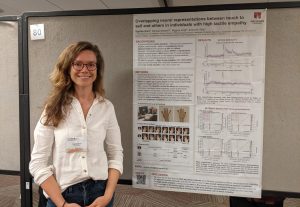 CNS 2022
CNS 2022
The annual meeting of the Cognitive Neuroscience Society last month brought together more than 1,000 attendees from all over the world, but three young researchers were noticeably absent. Only one of the four recipients of the Journal of Cognitive Neuroscience (JoCN) Travel Fellowship was able to make it to the meeting, due to pandemic-related backlogs at US consulate offices. While the fellows from the University of Delhi in India, Sabanci University in Turkey, and the Center for Neurosciences of Cuba were unable to attend, the fellow from Macquarie University in Australia was there to represent.
It was actually Sophie Smit’s first-ever international conference and first time leaving Australia in three years because of the pandemic. “Naturally I was super excited and also a little nervous to visit California and meet researchers from this part of the world,” she says. “But it was not only a fun experience but also a very useful one, as it helped me consolidate and expand my research ideas by talking to other academics with novel views and insights.”
Smit’s research, which won her the fellowship and which she presented at CNS 2022, looked at the neural underpinnings of “tactile empathy,” feeling touch observed on another person. “For example, if you watch a video of a hand being tickled by a feather, you might feel that same tickle on your own hand,” Smit explains.
Smit became interested in the topic due to her own disposition to strongly empathize with the emotions and experiences of the people around her. “It has always been fascinating to me that not everybody seems to do so,” she says, and so she wanted to answer the question: “What differs across brains that could drive such a wide spectrum of experiences?”
With colleagues, Smit set out to test the hypothesis that tactile empathy is linked to overlapping neural representations between feeling and observing touch. Using machine learning methods, the researchers analyzed whole-brain electroencephalography (EEG) recordings while participants saw videos of a hand being touched or directly felt touch to their own hand.
“We found that only in people with high tactile empathy, visually perceived touch evokes a very similar representation as directly feeling that touch,” she says. “This is an exciting finding because it provides a link between the precise mapping of self and others in the brain and the subjective experience of tactile empathy.”
Smit is grateful to have had the opportunity through the fellowship to attend CNS 2022 and hopes that those who couldn’t make it this year can attend in the future. She is especially grateful for the outreach from JoCN Editor-in-Chief Brad Postle and those from CNS Trainee Association who helped before and during the conference.
-Lisa M.P. Munoz



Leave a Reply
You must be logged in to post a comment.